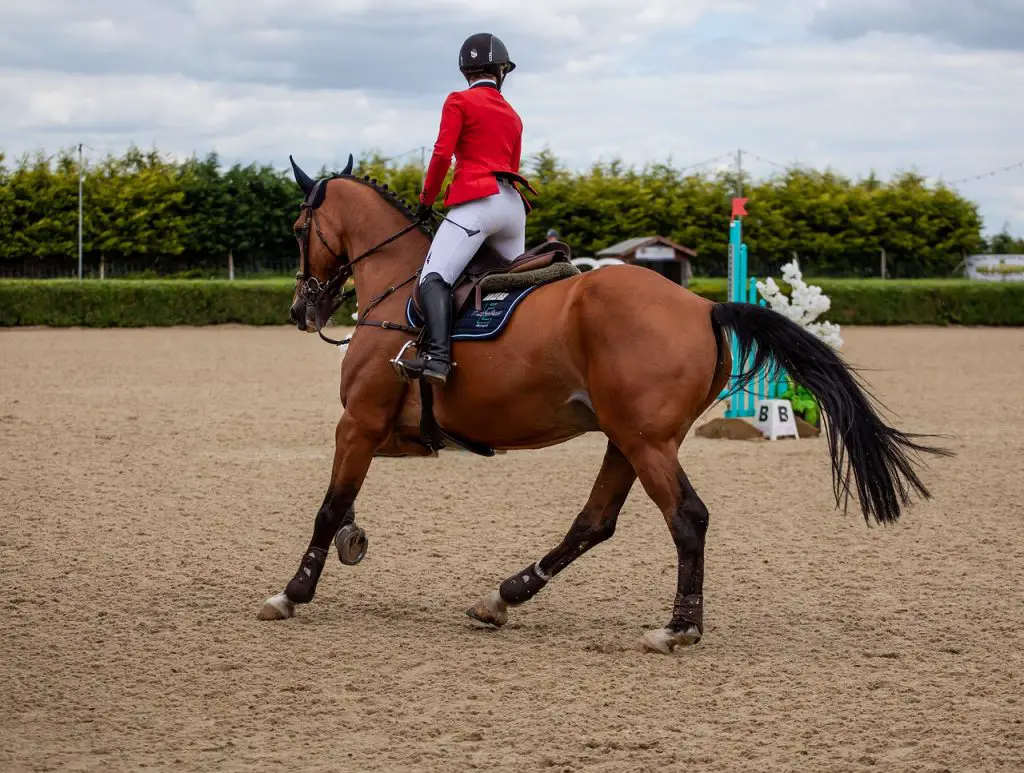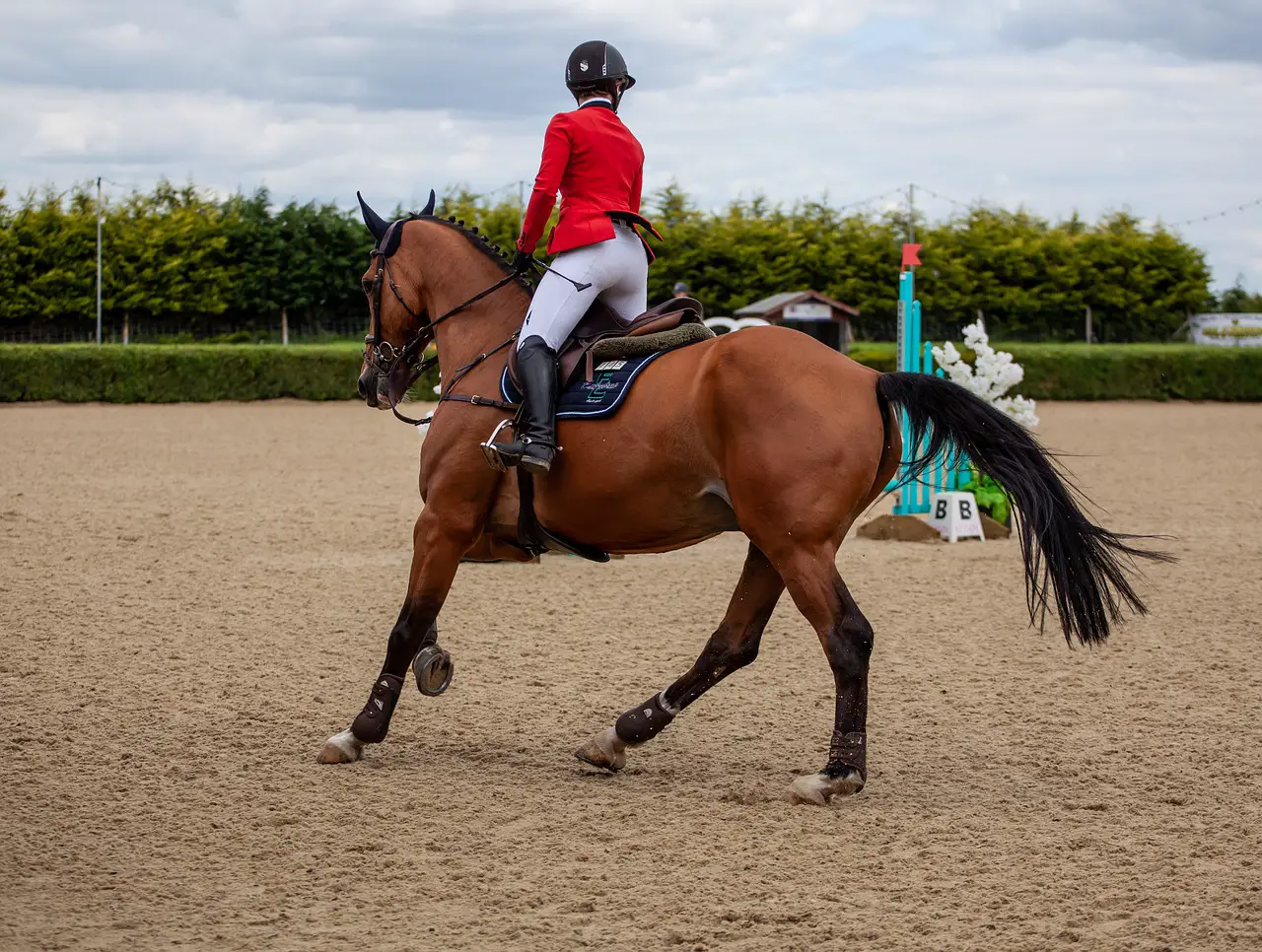Last Updated on March 24, 2022 by Allison Price
Riding in rising trot is one of the most important skills you will learn as a rider.
The ability to rise to the trot can be a very useful tool in many aspects of riding, such as warming up, controlling the trot’s pace, and even in lower-level dressage testing.
Many beginners have trouble with the rising trot. Keep reading to learn more about this important riding skill.
What is rising trot?
There are two main ways to ride the trot: sitting or rising.
More experienced and advanced riders are more comfortable using the sitting trot. You must be able to follow the horse’s movements with flexible hips and an independent seat to ensure you don’t bounce off the reins or attempt to balance.
Similar Read: Improve Your Sitting Trot
Both the horse and rider will find it easier to rise to the trot. You basically take your weight off the horse’s shoulders on each stride of the trot. This allows the horse to move freely and not disrupt the rhythm.
When should you use rising trot
Even if your sitting trot is perfect, there are many times you should still rise to the trot.
Warming-up
You should ride your horse in a rising trot when you are first warming him up.
Your horse’s muscles will be cold at the beginning of every schooling session. The horse’s muscles will gradually warm up by moving to the trot.

Cooling down
Similar to the previous step, allow your horse to cool down after each session. The warm-down should be done in the rising trot.
This means your horse’s muscles will gradually relax and stretch, decreasing the chance of injury or soreness.
Tempo control
Horses can trot at speeds that are too fast for some horses.
You can slow down the rate at which your rising is going. This allows you to directly control the pace of the trot without having to pull on the reins. This is especially useful in a competition setting.
Encourage stretching and free the horse’s back
You can encourage your horse to relax if he is tight and tense through his back.
A low-level dressage test may include where the horse is allowed to stretch out on a long rein for 20 meters. This exercise should be done in the rising trot, so the horse can swing his back and extend his shoulders. It adds more expression to his gaits.
Re-trained horses and young horses
Young horses should be ridden in rising trot as their muscles aren’t strong enough to support the weight of a rider in sitting trot.
This applies to horses being retrained from ex-racers.
Until the horse has learned to work properly and raise its back, it is best to avoid sitting trot.
Common errors in rising trot
A few rookie mistakes can ruin the rising trot.
- Don’t be a fool!
- Rearward leaning and following the horse’s movements
- Double-bouncing
- Balance requires you to use the reins
- Stirrups too long
- Landing heavily on the saddle or cantle
These problems are most often caused by the lack of balance and an independent seat. These mistakes can ruin the rhythm and affect the horse’s confidence.
Similar Reads:
The diagonal
You must ensure that you are sitting on the correct diagonal when going to trot. You can find a detailed article on how to ride correctly on the diagonal, and why it’s so important. However, here’s a quick summary:
The horse’s left foreleg swings forward as he trots. The trot’s rhythmical two-beat rhythm is created by the sync between the left hind leg (right foreleg) and left hind leg (left foreleg).
You can help your horse balance in turns and circles by riding on the correct sideways.
You must ensure that your horse is riding on the correct diagonal by sitting so that the horse’s outside shoulder touches the ground.
Every time you adjust the rein, it is important to change your diagonal by sitting for an extra beat.
Similar Read: Why you Should Ride on the Correct Diagonal
Develop a “feeling” for the rising trot
New riders spend far too much effort in standing up straight in the stirrups and getting as high as possible. This is not sustainable and the rider will soon tire.
The rider will become more comfortable as they gain more experience, and the entire exercise will be easier and more fluid.
You need to develop this “feel”
- Learn the basics of the trot
- Learn how to move your body when you are trotting.
- These movements are interconnected.
Let’s take a closer look at these elements.
1. The mechanics of the trot
The horse then trots by moving his left hind leg and right foreleg together, followed by his right foreleg. This is called ‘diagonal pairs’.
Between these periods, there is a suspension period where the horses’ legs do not touch the ground.
This gives the trot its rhythmic, two-time beat and spring.
Similar Read: The Horse’s Trot Gait In Dressage
The horse pushes the rider forward and up during suspension. Horses that move a lot are more comfortable to sit on and have more “push”. Horses with less movement are easier to ride, and the trot is easier for beginners.
2. In rising trot, the rider’s movements
Many beginners struggle to get up and fall. They either try to force their way up by grasping their knees or trying to hold on to their stirrup irons. Instead, focus on the mechanics of the trot and let the horse push you up and off the saddle.
You should have a smooth rising trot and be in complete sync with your horse.
You shouldn’t be able to ride a steady rising trot if you don’t want to rise vertically from the saddle. Instead, you should incline your upper body forwards, open your hip angle, and swing your hips forwards, while straightening the knees.
Your horse is moving forwards so you need to move forward. If you are going straight up and down, your horse will move forwards and you will fall behind it.
3 – How do the movements fit together
How do these movements all fit together?
We return to “feel”. When the horse moves forward, you should raise your head. You should sit for one beat when the horse’s feet touch the ground.
You should not force your horse to rise. This is the golden rule when working with horses. You risk the double-bounce. Relax, let the movement happen, and then relax!
Exercise 1 – For beginners
Rising trot can feel unnatural and fake when you first begin. This is a great exercise for beginners.
Step 1
Stand straight up in your stirrups, so your hips are above your knees. Your bottom will be out of the saddle.
Hold that position for ten second.
You can balance if you are unable to keep your balance.
Step 2
After you’re able to do this, continue the walk.
This exercise can be done while you’re walking. It will improve your balance and teach you how to feel the world around you.
Your legs should be directly below your hips. Allow your weight to fall into your heels. You’ll end up balancing backwards if your legs are too far forward. You’ll tip forward if your legs are too far back.
Exercise 2: Improve your rising trot
This exercise can help you feel the rising trot.
Step 1
You can ride the horse in a forward trot or in the two-point jumping chair so you don’t touch the horse’s back.
Step 2
After the trot has been established, count “up up, down. up, and down. etc.” Then, stand in the stirrups for two beats (“up”, up”), then get down for one beat (“down”)
Instead of trying to force yourself up and down mechanically, this exercise will allow you to feel the horse’s natural rhythm. Gradually your balance will improve and your leg will be stronger.
Step 3
You will feel the difference if you return to your regular rising trot.
Final words
Although many beginners have difficulty learning the rising trot, it’s an important skill for dressage riders.
A rising trot should be used to warm the horse up at the start of a schooling session, and then cool it down at the end. A rising trot can be used to control the pace and encourage relaxation in a horse that is tense.



